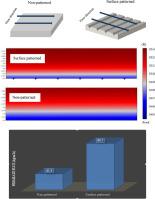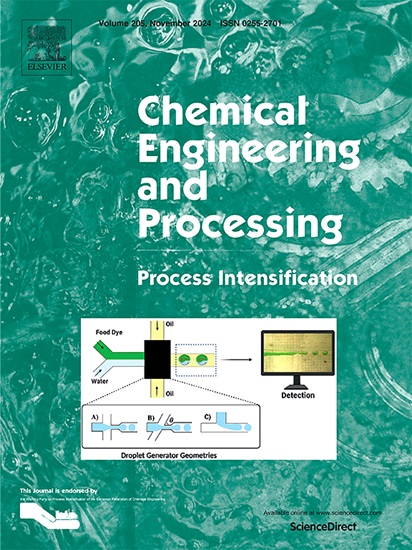通过膜表面图案化强化直接接触膜蒸馏(DCMD)脱盐过程:CFD 研究
IF 3.8
3区 工程技术
Q3 ENERGY & FUELS
Chemical Engineering and Processing - Process Intensification
Pub Date : 2024-10-13
DOI:10.1016/j.cep.2024.110027
引用次数: 0
摘要
本研究通过计算流体动力学(CFD)模拟,研究了图案几何形状对直接接触膜蒸馏法(DCMD)盐水脱盐表面图案膜性能强化的影响。应用 Comsol Multiphysics 软件求解了热量、动量和质量传递的支配传输方程。模型结果通过已公布的实验数据进行了验证,最大偏差为 10%。目标是通过改变表面图案的几何形状和尺寸使渗透流量最大化。根据之前的研究,本研究选择了棱柱图案,并研究了图案类型(3 种)、图案尺寸(25-150 µm 谷深)和谷间距(0-400 µm)对温度极化系数(TPC)和 DCMD 渗透通量的影响。结果表明,谷深为 25 µm、谷间距为 300 µm 的图案在 DCMD 运行中性能最佳。在这种情况下,进料温度为 80 °C,TPC 为 0.78,水流量为 49.3 kg m-12.h。此外,还对图案膜表面附近的流动特征进行了研究,结果表明,在沟谷的下部区域存在较弱的剪应力,而在上部区域则产生了较强的剪应力,这些剪应力是提高图案膜 TPC 和水通量的原因。本文章由计算机程序翻译,如有差异,请以英文原文为准。

Process intensification in the direct contact membrane distillation (DCMD) desalination by patterning membrane surface: A CFD study
In this research, the impact of pattern geometry on the intensification of the performance of surface patterned membranes for saline water desalination by direct contact membrane distillation (DCMD) is investigated by computational fluid dynamics (CFD) simulation. The Comsol Multiphysics software was applied to solve the governing transport equations for heat, momentum, and mass transfer. The result of the model was validated by the published experimental data, and the maximum deviation was <10 %. The target was to maximize the permeate flux by altering surface pattern geometry and dimensions. Based on the previous studies, a prism pattern was chosen in this work, and the influences of pattern type (3 types), pattern dimension (25–150 µm valley depth), and the distance between the valleys (0–400 µm) were studied on the temperature polarization coefficient (TPC) and DCMD permeate flux. The results showed that the pattern with a valley depth of 25 µm and a distance between the valleys of 300 µm had the best performance in DCMD operation. In this situation and feed temperature of 80 °C, a TPC of 0.78 and a water flux of 49.3 kg m-12.h were attained. The characteristics of flow close to the patterned membrane surface were also investigated, and it was observed that there are weak shear stresses in the lower zone of the valleys, while stronger shear stresses are created in the upper regions that are responsible for improving the TPC and water flux in the patterned membranes.
求助全文
通过发布文献求助,成功后即可免费获取论文全文。
去求助
来源期刊
CiteScore
7.80
自引率
9.30%
发文量
408
审稿时长
49 days
期刊介绍:
Chemical Engineering and Processing: Process Intensification is intended for practicing researchers in industry and academia, working in the field of Process Engineering and related to the subject of Process Intensification.Articles published in the Journal demonstrate how novel discoveries, developments and theories in the field of Process Engineering and in particular Process Intensification may be used for analysis and design of innovative equipment and processing methods with substantially improved sustainability, efficiency and environmental performance.

 求助内容:
求助内容: 应助结果提醒方式:
应助结果提醒方式:


